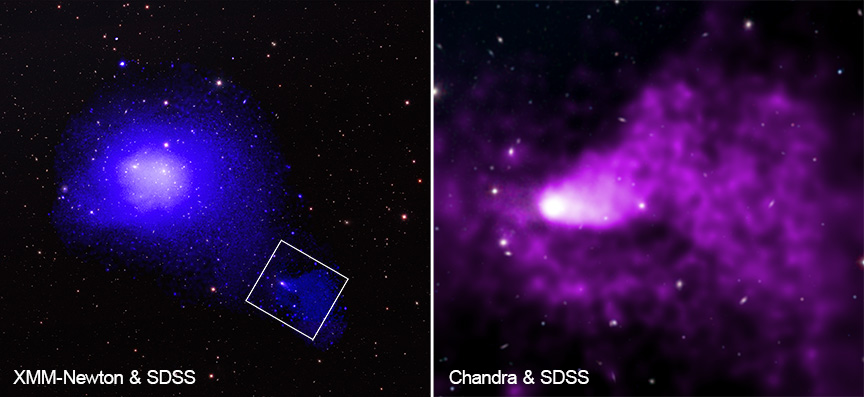Astronomers confirm longest known gas tail trailing behind a galaxy group

In a groundbreaking discovery, scientists have confirmed the longest-known tail of gas stretching behind a group of galaxies (collections of about 50 or less galaxies bound together by gravity). Named NGC 4839, the galaxy group lies near the edge of the Coma galaxy cluster, one of the largest known clusters in the universe about 340 million light-years away.
As the galaxy group moves toward the center of the Coma cluster, the hot gas in the galaxy group is stripped away by its collision with gas in the cluster, leaving a streak that glows in X-rays. The new data from NASA's Chandra Observatory reveals that the tail is 1.5 million light-years long. To put this into perspective, it is hundreds of thousands of times longer than the distance between the Sun and the nearest star, making it the longest tail ever seen trailing behind a group of galaxies.
The results will help astronomers learn more about how galaxy clusters grow to their enormous sizes.
A group of galaxies is plunging into the Coma galaxy cluster & leaving behind an extraordinary tail of superheated gas. This comet-like tail is 1.5 million light-years long, making it the longest tail ever seen trailing behind a group of galaxies. https://t.co/pt0I2Z2OxF #AAS242 pic.twitter.com/P39hTxBXP8
— Chandra Observatory (@chandraxray) June 6, 2023
According to the researchers, the gas in the tail behind NGC 4839 will ultimately merge with the large amount of hot gas already present in the Coma Cluster.
Using the Chandra data to analyze the gas positioned in front of the galaxy group, the scientists made an additional intriguing discovery. They detected a shock wave, similar to the sonic boom produced by a supersonic jet, indicating that NGC 4839 is hurtling through the galaxy cluster at an astonishing speed of about 3 million miles per hour.
Furthermore, the team examined the turbulence within the tail's gas and found that NGC 4839's gas displays a mild level of turbulence, suggesting low heat conduction within the galaxy group.
Additionally, the scientists identified possible evidence of a particular structure known as Kelvin-Helmholtz instabilities on one side of the gas tail. These structures are frequently observed in various space and terrestrial settings, such as cloud formations, and are caused by differences in the velocity of adjacent layers of moving gas or fluid. The presence of this structure within NGC 4839 implies that the gas within the tail possesses either a weak magnetic field or a low level of viscosity, according to the researchers.










